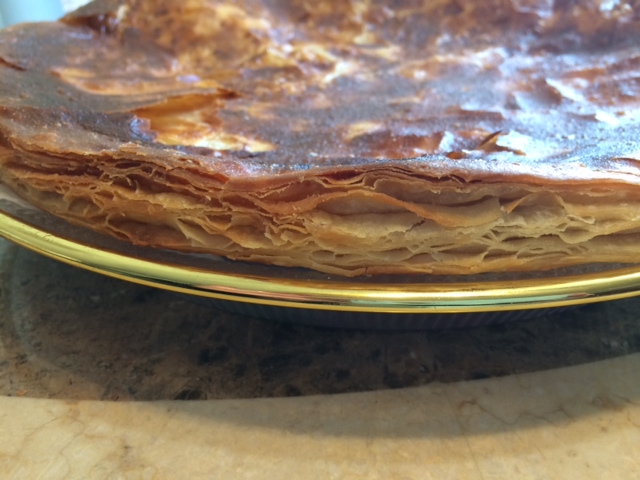History and Tradition Behind Bint al Sahn

In the diverse world of traditional cuisines, few dishes tell a story as rich and evocative as Bint al Sahn. This savory Yemeni delicacy, known for its intricate layers and delicate flavors, offers a glimpse into the cultural heritage and culinary traditions of Yemen. Bint al Sahn, which translates to “daughter of the tray” in Arabic, is much more than just a dish—it’s a symbol of Yemeni hospitality, history, and artistry.
Origins and Historical Significance
Bint al Sahn’s origins can be traced back to Yemen’s long and storied history. Yemen, strategically located at the southern tip of the Arabian Peninsula, has been a crossroads of trade and cultural exchange for centuries. Its culinary traditions are a melting pot of influences from the Middle East, Africa, and South Asia. Bint al Sahn embodies this amalgamation of flavors and techniques, reflecting Yemen’s rich and diverse heritage.
Historically, Yemeni cuisine was shaped by the country’s geographical and climatic conditions. Yemen’s rugged terrain and varying climates supported the cultivation of a variety of ingredients, from the fertile highlands that produced grains and vegetables to the coastal regions that offered seafood. The spices and herbs that flavored Yemeni dishes came through ancient trade routes, adding depth and complexity to their food.
The Artistry of Preparation
Bint al Sahn is a true testament to Yemeni culinary craftsmanship. This dish is often referred to as a “sweet and savory bread,” but it is much more complex than that. The preparation of Bint al Sahn involves a meticulous process that showcases the skill and patience of Yemeni cooks.
At its core, Bint al Sahn is a layered bread made from a simple dough enriched with ghee, a clarified butter that adds a distinct richness. The dough is rolled out thinly and layered, creating a pastry-like texture that is both light and hearty. Each layer is brushed with ghee and sometimes sprinkled with spices or herbs, resulting in a dish that is aromatic and flavorful.
One of the most remarkable aspects of Bint al Sahn is its presentation. The dish is traditionally baked in a large, flat tray, which gives it its name. The resulting bread is golden and flaky, with a texture that is both crispy on the outside and tender on the inside. It is often served cut into squares or pieces, making it easy to share and enjoy with family and friends.
Cultural and Social Significance
In Yemeni culture, food is more than just sustenance—it is a means of expressing hospitality and community. Bint al Sahn is a dish that embodies these values perfectly. It is often prepared for special occasions, such as religious celebrations, weddings, and family gatherings. The process of making Bint al Sahn is a communal activity, with family members coming together to prepare and enjoy the dish.
The act of preparing Bint al Sahn is also steeped in tradition. It is not uncommon for Yemeni families to pass down recipes and techniques through generations, preserving the authenticity and cultural significance of the dish. The preparation of Bint al Sahn often involves a combination of traditional methods and personal touches, allowing each cook to add their unique flair while honoring the time-honored techniques.
In addition to its role in special occasions, Bint al Sahn also plays a part in daily life. It is a common accompaniment to Yemeni coffee or tea, enjoyed as a snack or light meal. Its versatility makes it a staple in Yemeni households, where it is appreciated for both its taste and its ability to bring people together.

Modern Interpretations and Global Appreciation
In recent years, Bint al Sahn has gained recognition beyond Yemen’s borders. As the global interest in Middle Eastern cuisine grows, this dish has found its way into international food circles, where it is celebrated for its unique flavors and textures. Chefs and food enthusiasts around the world have begun to explore and experiment with Bint al Sahn, introducing it to new audiences and incorporating it into diverse culinary contexts.
Modern interpretations of Bint al Sahn often involve variations on the traditional recipe, with some cooks adding contemporary ingredients or adapting the dish for different dietary preferences. Despite these adaptations, the essence of Bint al Sahn remains intact, preserving its cultural significance and historical roots.
A Taste of Yemen’s Heritage
Bint al Sahn is more than just a dish—it is a reflection of Yemen’s rich cultural tapestry and culinary heritage. Its intricate layers and delicate flavors tell a story of tradition, artistry, and community. As this beloved Yemeni delicacy continues to captivate palates around the world, it serves as a reminder of the power of food to connect us to our past and to each other.
Whether enjoyed in a traditional Yemeni setting or experienced through modern adaptations, Bint al Sahn offers a unique and delicious window into Yemen’s history and traditions. Its enduring appeal is a testament to the timeless nature of good food and the enduring strength of cultural heritage.
In savoring a piece of Bint al Sahn, one can appreciate not just the flavors, but the centuries of history and tradition that have shaped this remarkable dish.


 How to Create a Successful Financial Freedom Plan
How to Create a Successful Financial Freedom Plan  How to Use Social Media for Brand Building
How to Use Social Media for Brand Building  SEO Tools vs. Manual Optimization
SEO Tools vs. Manual Optimization  How Interest Rates Affect Home Prices
How Interest Rates Affect Home Prices  Pets Analysis Online Ecommerce Store
Pets Analysis Online Ecommerce Store  Medical Alert System Costs
Medical Alert System Costs